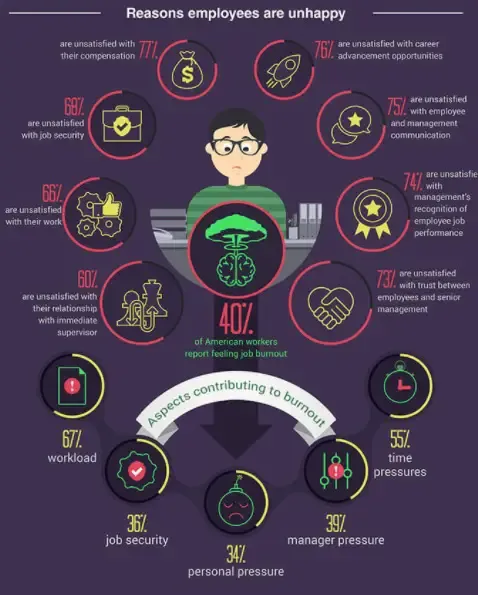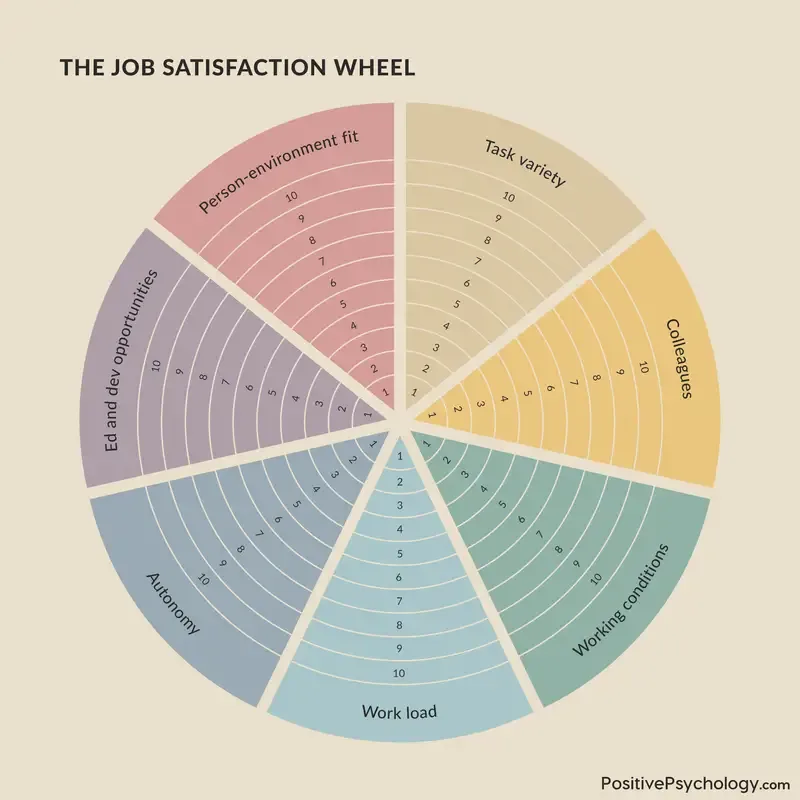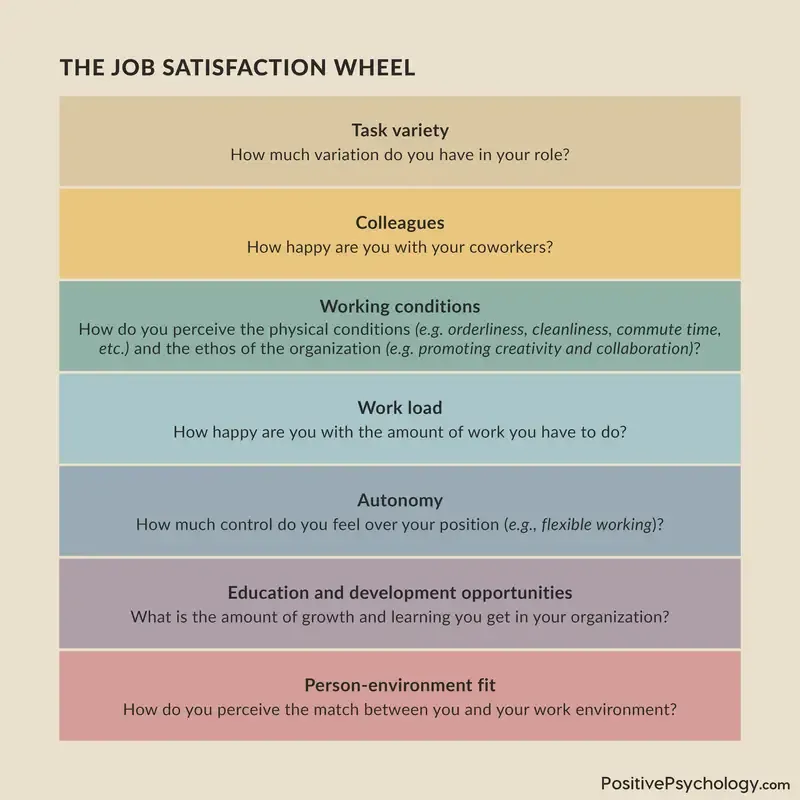What Is Job Satisfaction and Why Is It Important?
 Have you asked yourself lately if your job is right for you?
Have you asked yourself lately if your job is right for you?
Are you aware of what right actually means?
Determining whether you are satisfied with your job, whether it is right for you, and why that is important often involves personal intuition and circumstances. For some people, the right job might entail earning a certain salary. For others, the right job might involve having a supportive team.
With more than 21,000 participants in their study, researchers Dobrow, Ganzach, and Liu (2018) found that over a 40-year span, people who stayed in the same organization over time became less satisfied, and people who moved to different organizations over time became happier.
What does this mean? Does job satisfaction come from staying in an organization or leaving it? If someone were to stay in an organization, what would retain their satisfaction?
In this article, we will explore just that and more, including divulging the ingredients of job satisfaction, real-life examples of it, and how it relates to motivation.
Before you continue, we thought you might like to download our three Work & Career Coaching Exercises for free. These detailed, science-based exercises will help you or your clients identify opportunities for professional growth and create a more meaningful career.
This Article Contains:
What Is Job Satisfaction?
Choose a job you love, and you will never have to work a day in your life.
Confucius
You have probably heard that quote before, yet it may still have relevance today. It makes us ask whether emotions like happiness, stress, and anxiety play an important role in job satisfaction.
The aptly titled Job Satisfaction (Hoppock, 1935) defines job satisfaction as any combination of psychological, physiological, and environmental circumstances that cause a person to truthfully say that they are satisfied with a job.
Going a little deeper and fast-forwarding to this century, job satisfaction has been called a set of favorable or unfavorable feelings and emotions with which employees view their work (Karatepe, Uludag, Menevis, Hadzimehmedagic, & Baddar, 2006).
Before we get to favorable feelings or proven ingredients for job satisfaction, let’s first assess what leads to those unfavorable feelings.
The graphic above from the University of Southern California’s Applied Psychology Program shows some factors that make American employees unhappy or burnt out with jobs.
Many of us have experienced unhappiness because of these factors and more at some point in our careers. Let’s take a look at what can be done to satisfy ourselves in a job.
10 Proven Ingredients for Job Satisfaction

Although it is subjective, job satisfaction research (Kumari, 2011) has showcased the following:
1. Communication
Communication can be extremely important to retaining levels of satisfaction, on both a personal and professional level. It is exhibited in allowing employees to be open, collaborative, trustworthy, and even confrontational when needed.
2. Culture
Defining a company culture links to job satisfaction as it provides values and guidance about topics ranging from organizational goals to appropriate levels of interaction between employees.
3. Security
It’s no surprise that once a culture is established in a workplace, satisfaction can then be enhanced by added feelings of security. Security may arise from knowing you work for a viable company with long-term goals, insinuating feelings of belonging to that company (Berg, Grant, & Johnson, 2010). This can be enhanced by having honest communication and transparency within a company.
4. Leadership
Tied into increased motivation for employees, leadership, or influencing a group toward the achievement of a vision or set of goals (Kinicki & Kreitner, 2006), can lead to job satisfaction by making sure communication and instruction of tasks is adequate and easily understood.
In turn, when employees feel that leaders can guide them through tasks, their motivation and satisfaction increases.
With leadership having a crucial influence on job satisfaction, this related article with leadership activities is a recommended read.
5. Opportunities
Employees can gain more satisfaction with their job when more challenging opportunities arise. This can lead to participation in interesting and diverse projects and get employees away from the monotony of a role.
6. Career development
Employees can become more satisfied with their job when they know there is an individualized plan for them. Beyond the formal nature of appraisals, if there is a path in place for growth, this can encourage employees to stay happier for longer.
7. Working conditions
Job satisfaction can be increased if a resilient workplace is a cooperative environment. This means a place with respect for diverse ideas and opinions, honest and constructive feedback, mentoring opportunities, and freedom from harassment.
8. Employee personality
Most ingredients linked to job satisfaction may have roots in elements outside of the employees’ control (such as leadership from managers and communication from company leaders), but what about the employees themselves? Can they control their own levels of satisfaction? Bakker, Tims, and Derks (2012) talk about just that.
These researchers discuss how job satisfaction can be determined by how proactive the employee is at work. Does the employee proactively seek out a manager for feedback? Does the employee go the extra mile to achieve tasks within a company? Does the employee try to stick to company goals, lead meetings, and ask questions when unsure about how to complete a task?
If yes, these employees are ones who can show more satisfaction in the workplace. Proactiveness in the workplace can lead to positive job appraisals, which when fed back to the employee, can lead to satisfaction.
For more on constructive feedback, read our article discussing ways to give negative feedback constructively.
9. Pay and benefits
Organizational success and job satisfaction are also linked to employees’ perceptions of adequate pay and benefits (Edwards, 2008).
While pay and benefits are not the only reason employees find satisfaction in their workplaces, research going back more than 30 years (e.g., Gerhart, 1987) shows that pay and benefits, at least according to how employees view themselves in their roles, has ranked high on lists of job satisfaction factors.
10. Rewards and recognition
Beyond monetary gain and being paid fairly for the work they do, job satisfaction for employees means that promotional policies are unambiguous and in line with their expectations.
A key finding here (Kumari, 2011) is that satisfaction at a job is not exclusively linked to pay, but to the perceived fairness of how one is recognized at work for achievements.
Is Job Satisfaction Important? 4 Benefits
We have already discussed what employees look for in achieving and maintaining job satisfaction. But why is it important? And why should organizations care?
First, it is a primary responsibility of organizations to ascertain that employees are satisfied with their jobs through measurements, but also to find out the causes of dissatisfaction when employees are not feeling satisfied (McBride, 2002).
Tools such as the following help measure some important factors that go into employees’ job satisfaction (Spector, 1997, chapter 2):
- Job Satisfaction Survey (Spector, 1985)
- Job Description Index (Castanheira, 2014)
- The Minnesota Satisfaction Questionnaire (Weiss, Dawis, and England, 1967)
As to why job satisfaction is so important, the Employee Job Satisfaction and Engagement Report from the Society for Human Resource Management (Lee et al., 2016) notes four benefits of making sure employees are satisfied with their work.
1. Increased profits
This is one any manager and employee might appreciate. Keeping employees satisfied can lead to higher sales, lower costs, and a stronger bottom line.
2. Higher productivity
Irrespective of their job titles or salary, employees who are more satisfied with their job, whether they feel satisfied with the organizational culture, with the rewards they are getting, or with recognition, can produce more and do it more efficiently.
3. Lower turnover
If employees are more satisfied with their job, they are less likely to leave. It also helps to recruit better quality talent as new talent sees employee staying power as added value.
4. Loyalty
When employees feel there is a growth path for them, they are more satisfied. In turn, because they feel the organization has their best interests at heart, they tend to support the organization’s mission and objectives. When this happens, employees may tell their friends or relatives about the good nature of the organization, which helps spread organizational goodwill.
The Job Satisfaction Wheel can help assess your current job satisfaction and identify improvement areas. Job satisfaction measures subjective wellbeing at work (Judge & Klinger, 2008).
According to Roelen et al. (2008), there are seven key indicators of job satisfaction:
- Task variety
- Colleagues
- Working conditions
- Workload
- Autonomy
- Education and development opportunities
- Person-environment fit
Here’s how you can use the Job Satisfaction Wheel:
- Rate the seven job satisfaction domains on a scale from one – “not at all satisfied” to ten – “completely satisfied”. Place a circle around each score on the wheel.
- Connect your scores by drawing a line and forming an inner wheel. This gives you an overview of how satisfied you are with your current job.
- Looking at the wheel, where do you see areas for improvement? What would it take to improve the score? Which action steps can you take?
2 Real-Life Examples
Honesty and communication about a company’s objectives and goals can be vital and are linked to job satisfaction for employees. But do employees only care about company success? How does honest communication impact their own, individual success?
The importance of honesty and communication
Agarwal and Mehta (2014) were interested in employee job satisfaction within the IT industry.
Their curiosity stemmed from the idea that IT employees may largely be working in isolation, away from other employees, and the researchers wondered if employees valued appraisals more in such circumstances than in other industries. They discussed how performance appraisal was directly linked to satisfaction (or dissatisfaction) for the employee.
Additionally, they also discuss how honest and consistent communication and regular updates of employee progress (bi-annual rather than yearly appraisals) can not only increase employee satisfaction at work, but also help companies by decreasing the rate of attrition. Interestingly enough, Agarwal and Mehta (2014) did not discuss company goals or performance in their findings.
Let’s take a look at some familiar companies you may have heard of.
Starbucks
Although the phrase “the customer is always right” may be common, it does not seem to ring all true behind the scenes (or the counter, in this case).
The CEO’s mantra was that if managers look out for employees, employees will look after customers. To do this, he offered health insurance to all employees despite the excessive cost and being advised against it.
Is it surprising that good leadership strengths, recognition, and reward given to employees increased job satisfaction and in turn increased profits for Starbucks? It certainly fits in line with the aforementioned research in this article.
While also producing satisfied end-users like us when using Google’s products, Google puts a lot of work into job satisfaction for its employees as well.
It’s interesting to note that Google does not care (perhaps as much) about employee titles, but more about what type of leaders its employees are, or emergent leadership. This draws us back to the importance of positive leadership in job satisfaction.
Gillett (2016) writes that Google attracts talent with competitive pay and keeps employees satisfied by allowing telecommuting. This may show an appreciation for work–life balance and retention.
Gillett also writes that according to compensation and data company PayScale, nearly three-quarters of Google employees find their jobs meaningful, citing that Google’s mission is to organize the world’s information and make it universally accessible and useful.
She describes Google employees thinking that their goal of working at Google is a moral rather than a business goal, which in turn creates motivation to innovate and push into new areas.
These sound like great organizational goals that drive profits. Furthermore, Google staff certainly demonstrate that job satisfaction can indeed lead to employees supporting the organization’s goals and objectives.
A Note on Job Satisfaction and Motivation

According to Latham (2012), motivation is a cognitive resource allocation process in which a person makes choices as to the time and energy to be allocated to an array of motives or tasks. The key word here seems to be choice.
When an employee is able to make a choice, they feel more motivated to perform a task. When an employee is more motivated to perform and complete a task, this tends to be linked with higher job satisfaction (Jalagat, 2016).
Choice, as directed or allowed by organizational policy, can lead to further motivation and, in turn, job satisfaction as well as performance. This seems to be echoed by the work of Ilies and Judge (2003).
Ilies and Judge (2003) discuss how leaders interact with employees, specifically by talking to them more as a person, and how assigning tasks and providing a career path can affect their motivation level.
When determining job satisfaction, it is key to remember that human factors such as motivation, excitement, satisfaction, and dissatisfaction must be considered. This is clearly indicated by the Starbucks example.
When employees are encouraged to be great leaders and to engage in challenging opportunities, such as at Google, they can end up feeling more satisfied with their job.
PositivePsychology.com’s Job Satisfaction Tools
As one of the key ingredients of job satisfaction, communication among employees, managers, and staff cannot be underestimated.
However, communication is not automatically generated or achieved right away. When introducing new employees into a workplace, it may be even more important to establish good and fun communication procedures between employees.
This helpful article with work-related communication games and exercises can help improve communication at the workplace.
For other ways to establish happiness in the workplace, this article offers a guide and tips for making employees happier.
To determine your own job satisfaction, you need to do an assessment of your strengths and skills. This tool guides you to complete a Strengths In Challenging Times worksheet in order to do exactly that.
Another invaluable tool based on the Japanese concept of ikigai is Job Crafting of Ikigai. It is an interesting exercise that helps you understand what fuels your passions and, in turn, change aspects of your role to make it more fulfilling.
If you’re looking for more science-based ways to help others manage stress without spending hours on research and session prep, this collection contains 17 validated stress management tools for practitioners. Use them to help others identify signs of burnout and create more balance in their lives.
A Take-Home Message
Job satisfaction can be a two-way street. Employees need to feel satisfied, and organizations must help employees realize their potential.
If you are interested in increasing the job satisfaction of your employees, be sure to look beyond the seemingly practical benefits of providing adequate salaries and health insurance, although those too are critical.
Motivating employees may be just as important. Job satisfaction links to motivation, which employees can gain even more of when realizing their full potential. Besides providing adequate salaries and health insurance, much more can be done by companies to motivate and guide employees. In turn, companies will reap the benefits of loyalty and shared objectives.
We hope you enjoyed reading this article. Don’t forget to download our three Work & Career Coaching Exercises for free.
- Agarwal, R. N., & Mehta, A. (2014). Impact of performance appraisal and working environment on the job satisfaction and attrition problem in the Indian IT industry. Paradigm, 18(1), 73–85.
- Bakker, A. B., Tims, M., & Derks, D. (2012). Proactive personality and job performance: The role of job crafting and work engagement. Human Relations, 65(10), 1359–1378.
- Berg, J. M., Grant, A. M., & Johnson, V. (2010). When callings are calling: Crafting work and leisure in pursuit of unanswered occupational callings. Organizational Science, 21(5), 973–994.
- Castanheira, F. (2014). Job Descriptive Index. In A. C. Michalos (Ed.), Encyclopedia of quality of life and well-being research. Springer.
- Edwards, J. R. (2008). To prosper, organizational psychology should overcome methodological barriers to progress. Journal of Organizational Behavior, 29(4), 469–491.
- Gerhart, B. (1987). How important are dispositional factors as determinants of job satisfaction? Implications for job design and other personnel programs. Journal of Applied Psychology, 72(3), 366–373.
- Gillett, R. (2016, April 28). 5 reasons Google is the best place to work in America and no other company can touch it. Business Insider. Retrieved October 25, 2020, from:
https://www.businessinsider.com/google-is-the-best-company-to-work-for-in-america-2016-4?r=US&IR=T - Hoppock, R. (1935). Job satisfaction. Harper and Brothers.
- Ilies, R., & Judge, T. A. (2003). On the heritability of job satisfaction: the mediating role of personality. Journal of Applied Psychology, 88(4), 750–59.
- Jalagat, R., Jr., (2016). Job performance, job satisfaction, and motivation: A critical review of their relationship. International Journal of Advances in Management and Economics, 5(6), 36–43.
- Judge, T. A., Heller, D., & Klinger, R. (2008). The dispositional sources of job satisfaction: A comparative test. Applied Psychology, 57(3), 361-372.
- Karatepe, O. M., Uludag, O., & Menevis, I., Hadzimehmedagic, L., & Baddar, L. (2006). The effects of selected individual characteristics on frontline performance and job satisfaction. Journal of Tourism Management, 27(4), 547–560.
- Kinicki, A., & Kreitner, R. (2006). Organizational behavior: Key concepts, skills & best practices. McGraw Hill.
- Kumari, N. (2011). Job satisfaction of the employees at the workplace. European Journal of Business and Management, 3(4), 11–30.
- Latham, G. P. (2012). Work motivation – History, theory, research and practice. SAGE Publications.
- Lee, C., Alonso, A., Esen, E., Coombs, J., Mulvey, T., Victor, J., & Wessels, K. (2016). Employee job satisfaction and engagement: Revitalizing a changing workforce. Report prepared by the Society for Human Resource Management.
- McBride, E. L. (2002). Employee satisfaction: Code red in the workplace? Journal of Nursing Management, 10(3), 157–163.
- Dobrow, S. R., Ganzach, Y., & Liu, Y. (2018). Time and job satisfaction: A longitudinal study of the differential roles of age and tenure. Journal of Management, 44(7), 2558–2579.
- Roelen, C. A. M., Koopmans, P. C., & Groothoff, J. W. (2008). Which work factors determine job satisfaction?. Work, 30(4), 433-439.
- Spector, P. E. (1985). Measurement of human service staff satisfaction: Development of the Job Satisfaction Survey. American Journal of Community Psychology, 13(6), 693–713.
- Spector, P. E. (1997). Job satisfaction: Application, assessment, causes, and consequences. SAGE Publications, Inc.
- Weiss, D. J., Dawis, R. V., & England, G. W. (1967). Manual for the Minnesota Satisfaction Questionnaire. Minnesota Studies in Vocational Rehabilitation, 22, 120.
Let us know your thoughts
Read other articles by their category
- Body & Brain (42)
- Coaching & Application (54)
- Compassion (26)
- Counseling (50)
- Emotional Intelligence (24)
- Gratitude (18)
- Grief & Bereavement (21)
- Happiness & SWB (40)
- Meaning & Values (25)
- Meditation (20)
- Mindfulness (44)
- Motivation & Goals (43)
- Optimism & Mindset (32)
- Positive CBT (25)
- Positive Communication (20)
- Positive Education (45)
- Positive Emotions (30)
- Positive Leadership (14)
- Positive Psychology (32)
- Positive Workplace (33)
- Productivity (16)
- Relationships (41)
- Resilience & Coping (34)
- Self Awareness (20)
- Self Esteem (36)
- Software & Apps (13)
- Strengths & Virtues (30)
- Stress & Burnout Prevention (34)
- Theory & Books (44)
- Therapy Exercises (35)
- Types of Therapy (58)








What our readers think
Job satisfaction has really been discussed from the perspective of positive psychology. Stories from the market like that of Google makes this material even more user-friendly. Kudos to you PositivePsychology.com!
I am writing a paper on Employee Engagement and comparing this with job satisfaction. This is one of the clearest and most coherent articles I have found on the subject. I will be bookmarking the sight for further use.